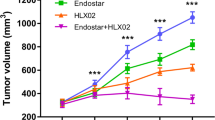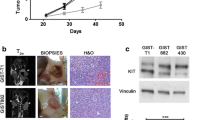Abstract
Objective
This study aims to explore the feasibility of dynamic contrast-enhanced magnetic resonance imaging (DCE-MRI) and blood oxygen level-dependent magnetic resonance imaging (BOLD-MRI) in assessing vessel function and tumour aggressiveness during anti-angiogenesis treatment.
Materials and methods
A colon cancer xenograft model was established in BALB/C nude mice with the HCT116 cell line. Sixteen mice were randomly divided into Group A and Group B, which were treated with saline or bevacizumab by intraperitoneal injection on the 1st, 4th, 7th, 10th and 13th days and underwent DCE-MRI and BOLD-MRI examinations before and on the 3rd, 6th, 9th, 12th and 15th days after treatment. Group C was treated with oxaliplatin monotherapy, and Group D was treated with bevacizumab and oxaliplatin as a point of comparison for therapeutic effects. The pathological examinations included HE, HIF-1α, fibronectin and TUNEL staining, as well as α-SMA and CD31 double staining. One-way analysis of variance and correlation analysis were the main methods used for statistical analysis.
Results
Group D manifested the highest tumour inhibition rate and smallest tumour volume on day 15, followed by Group C, Group B and Group A. Ktrans (F = 81.386, P < 0.001), Kep (F = 45.901, P < 0.001), Ve (F = 384.290, P < 0.001) and R2* values (F = 89.323, P < 0.001) showed meaningful trends with time in Group B but not Group A. The Ktrans values and tumour vessel maturity index (VMI) were higher than baseline values 3–12 days after bevacizumab treatment. The CD31 positive staining rate and VMI had the strongest correlations with Ktrans values, followed by AUC180, Ve and Kep values. The R2* value positively correlated with the positive staining rates of HIF-1α and fibronectin.
Conclusion
Intermittent application of low-dose anti-angiogenic inhibitor treatment may help improve the effect of chemotherapy by reducing hypoxia-related treatment resistance and improving drug delivery. DCE-MRI is useful for evaluating vessel maturity and vascular normalization, while BOLD-MRI may help to predict tumour hypoxia and metastatic potential after anti-vascular treatment.







Similar content being viewed by others
References
Jain RK, Di Tomaso E, Duda DG et al (2007) Angiogenesis in brain tumours. Nat Rev Neurosci 8:610–622. https://doi.org/10.1038/nrn2175
Huang Y, Lin D, Taniguchi CM (2017) Hypoxia inducible factor (HIF) in the tumor microenvironment: friend or foe? Sci China Life Sci 60:1114–1124. https://doi.org/10.1007/s11427-017-9178-y
Xiong H, Yin P, Li X et al (2019) The features of cerebral permeability and perfusion detected by dynamic contrast-enhanced magnetic resonance imaging with Patlak model in relapsing-remitting multiple sclerosis. Ther Clin Risk Manag 15:233–240. https://doi.org/10.2147/TCRM.S189598
Yeldag G, Rice A, Del Rio Hernandez A (2018) Chemoresistance and the self-maintaining tumor microenvironment. Cancers (Basel) 10:E471. https://doi.org/10.3390/cancers10120471
Diaz RJ, Ali S, Qadir MG et al (2017) The role of bevacizumab in the treatment of glioblastoma. J Neurooncol 133:455–467. https://doi.org/10.1007/s11060-017-2477-x
Viallard C, Larrivee B (2017) Tumor angiogenesis and vascular normalization: alternative therapeutic targets. Angiogenesis 20:409–426. https://doi.org/10.1007/s10456-017-9562-9
Pan JH, Zhu S, Huang J et al (2018) Monitoring the process of endostar-induced tumor vascular normalization by non-contrast intravoxel incoherent motion diffusion-weighted MRI. Front Oncol 8:524. https://doi.org/10.3389/fonc.2018.00524
Choi YJ, Lee IS, Song YS et al (2019) Diagnostic performance of diffusion-weighted (DWI) and dynamic contrast-enhanced (DCE) MRI for the differentiation of benign from malignant soft-tissue tumors. J Magn Reson Imaging. https://doi.org/10.1002/jmri.26607
Wu C, Pineda F, Hormuth DA 2nd et al (2019) Quantitative analysis of vascular properties derived from ultrafast DCE-MRI to discriminate malignant and benign breast tumors. Magn Reson Med 81:2147–2160. https://doi.org/10.1002/mrm.27529
Cao J, Pickup S, Clendenin C et al (2018) Dynamic contrast-enhanced MRI detects responses to stroma-directed therapy in mouse models of pancreatic ductal adenocarcinoma. Clin Cancer Res. https://doi.org/10.1158/1078-0432.ccr-18-2276
Zhou H, Belzile O, Zhang Z et al (2019) The effect of flow on blood oxygen level dependent (R 2 *) MRI of orthotopic lung tumors. Magn Reson Med. https://doi.org/10.1002/mrm.27661
Bonetti A, Giuliani J, Muggia F (2014) Targeted agents and oxaliplatin-containing regimens for the treatment of colon cancer. Anticancer Res 34:423–434
Huang Y, Yuan J, Righi E et al (2012) Vascular normalizing doses of antiangiogenic treatment reprogram the immunosuppressive tumor microenvironment and enhance immunotherapy. Proc Natl Acad Sci USA 109:17561–17566. https://doi.org/10.1073/pnas.1215397109
Loveless ME, Halliday J, Liess C et al (2012) A quantitative comparison of the influence of individual versus population-derived vascular input functions on dynamic contrast enhanced-MRI in small animals. Magn Reson Med 67:226–236. https://doi.org/10.1002/mrm.22988
Tofts PS, Brix G, Buckley DL et al (1999) Estimating kinetic parameters from dynamic contrast-enhanced T(1)-weighted MRI of a diffusable tracer: standardized quantities and symbols. J Magn Reson Imaging 10:223–232
Syed AK, Woodall R, Whisenant JG et al (2019) characterizing trastuzumab-induced alterations in intratumoral heterogeneity with quantitative imaging and immunohistochemistry in HER2+ breast cancer. Neoplasia 21:17–29. https://doi.org/10.1016/j.neo.2018.10.008
Robinson SP, Rodrigues LM, Howe FA et al (2001) Effects of different levels of hypercapnic hyperoxia on tumour R-2* and arterial blood gases. Magn Reson Imaging 19:161–166. https://doi.org/10.1016/S0730-725x(01)00230-2
Li F, Lee KE, Simon MC (2018) Detection of hypoxia and HIF in paraffin-embedded tumor tissues. Methods Mol Biol 1742:277–282. https://doi.org/10.1007/978-1-4939-7665-2_24
Alarcon-Martinez L, Yilmaz-Ozcan S, Yemisci M et al (2018) Capillary pericytes express alpha-smooth muscle actin, which requires prevention of filamentous-actin depolymerization for detection. Elife 7:e34861. https://doi.org/10.7554/eLife.34861
Eberhard A, Kahlert S, Goede V et al (2000) Heterogeneity of angiogenesis and blood vessel maturation in human tumors: implications for antiangiogenic tumor therapies. Cancer Res 60:1388–1393
Roodink I, Leenders WP (2010) Targeted therapies of cancer: angiogenesis inhibition seems not enough. Cancer Lett 299:1–10. https://doi.org/10.1016/j.canlet.2010.09.004
Li N, Zheng D, Wei X et al (2012) Effects of recombinant human endostatin and its synergy with cisplatin on circulating endothelial cells and tumor vascular normalization in A549 xenograft murine model. J Cancer Res Clin Oncol 138:1131–1144. https://doi.org/10.1007/s00432-012-1189-z
Shi C, Liu D, Xiao Z et al (2017) Monitoring tumor response to antivascular therapy using non-contrast intravoxel incoherent motion diffusion-weighted MRI. Cancer Res 77:3491–3501. https://doi.org/10.1158/0008-5472.CAN-16-2499
El Alaoui-Lasmaili K, Faivre B (2018) Antiangiogenic therapy: markers of response, “normalization” and resistance. Crit Rev Oncol Hematol 128:118–129. https://doi.org/10.1016/j.critrevonc.2018.06.001
Raza A, Franklin MJ, Dudek AZ (2010) Pericytes and vessel maturation during tumor angiogenesis and metastasis. Am J Hematol 85:593–598. https://doi.org/10.1002/ajh.21745
Yang J, Liao C, Liu Y et al (2018) MR imaging biomarkers evaluating vascular normalization window after anti-vessel treatment. Oncotarget 9:11964–11976. https://doi.org/10.18632/oncotarget.22600
Darden J, Payne LB, Zhao H et al (2019) Excess vascular endothelial growth factor-A disrupts pericyte recruitment during blood vessel formation. Angiogenesis 22:167–183. https://doi.org/10.1007/s10456-018-9648-z
Liang J, Ma R, Chen H et al (2019) Detection of hyperacute reactions of desacetylvinblastine monohydrazide in a xenograft model using intravoxel incoherent motion DWI and R2* mapping. AJR Am J Roentgenol 212:717–726. https://doi.org/10.2214/ajr.18.20517
Griggs LA, Hassan NT, Malik RS et al (2017) Fibronectin fibrils regulate TGF-beta1-induced epithelial–mesenchymal transition. Matrix Biol 60–61:157–175. https://doi.org/10.1016/j.matbio.2017.01.001
Oudin MJ, Jonas O, Kosciuk T et al (2016) Tumor cell-driven extracellular matrix remodeling drives haptotaxis during metastatic progression. Cancer Discov 6:516–531. https://doi.org/10.1158/2159-8290.CD-15-1183
Acknowledgements
This work was supported by Science and Technology Planning Project of Guangdong Province [Grant Number 2017A020215065], Key Program of Natural Science Foundation of Guangdong Province of China [Grant Number 2018B0303110011], National Natural Science Foundation of China [Grant Number 21317241], Guangzhou Key Laboratory of Molecular and Functional Imaging for Clinical Translation [Grant Number 201905010003] and Engineering Research Center of Medical Imaging Artificial Intelligence for Precision Diagnosis and Treatment, Guangdong Province.
Author information
Authors and Affiliations
Corresponding authors
Ethics declarations
Conflict of interest
The authors have stated explicitly that there are no conflicts of interest in connection with this article.
Additional information
Publisher's Note
Springer Nature remains neutral with regard to jurisdictional claims in published maps and institutional affiliations.
Electronic supplementary material
Below is the link to the electronic supplementary material.
Supplementary material 1 (TIFF 519 kb)
Supplemental Fig. 1. The uptake of contrast agent and arterial input function for a representative animal. A rapid wash-in of high concentration of contrast agent up to a sharp peak concentration and a bi-exponentially decaying wash-out period were observed after a bolus injection. A pseudo-colour image of Ktrans that covers the tumour region was generated after fitting the vascular input function to the Tofts model
Rights and permissions
About this article
Cite this article
Liang, J., Cheng, Q., Huang, J. et al. Monitoring tumour microenvironment changes during anti-angiogenesis therapy using functional MRI. Angiogenesis 22, 457–470 (2019). https://doi.org/10.1007/s10456-019-09670-4
Received:
Accepted:
Published:
Issue Date:
DOI: https://doi.org/10.1007/s10456-019-09670-4




